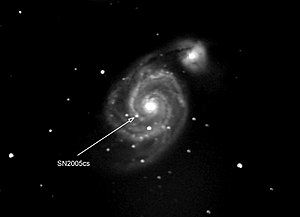Supernova

Asupernovais the explosion of agiant star.It usually happens when thenuclear fusionin the star cannot hold the core against its own gravity.[1]The core collapses, and then explodes.
The biggest stars that make supernovae arehypergiantsand smaller ones aresupergiants.They aremassive:because ofgravity,they use up their energy very quickly. Normally they only live for a few million years.
During the explosion, the total energy radiated by supernovae may briefly outshine the entire output of agalaxy.Theyemitenergy equal to that of the whole lifetime of a solar-like star.[2]The explosion blows off its stellar material away from the star, at velocities up to 30,000 km/s or 10% of the speed of light.[3]This drives ashock waveinto the surroundinginterstellar medium.This sweeps up an expanding shell of gas and dust, which we see as a supernova remnant. After exploding, what is left becomes ablack holeor aneutron star.
Most stars are small and do not explode. After theirred giantphase, they become colder and smaller and becomewhite dwarfstars.[4]
Supernova explosions happen rarely. The last time people saw a supernova in our owngalaxy,theMilky Way,was in the year1604.We can see supernovas in other galaxies too. Every year we see 300 supernovas in other galaxies, because there are so many galaxies. Sometimes they are brighter than the whole rest of the galaxy.
Types[change|change source]
Supernovas are usually sorted intoType IandType IIsupernovas.[5]
Type Isupernovas haveabsorption linesthat show they do not havehydrogenin them.Type Iasupernovas are very bright for a short amount of time. Then they get less bright very quickly. Type Ia supernovas happen when awhite dwarfstar isorbitinga big star. Sometimes, the white dwarf star sucksmatteroff of the big star. When the white dwarf eventually gets to be about 1.4 times themassof the sun, itcollapses.This makes lots of energy and light, which is why supernovas are very bright. Type 1a have mostly the same brightness. This allows them to be used as a secondarystandard candleto measure the distance to their host galaxies.[6]
Type IIsupernovas have absorption lines that show they do have hydrogen in them. A star must have at least 8 times, and no more than 40–50 times, themass of the Sunto undergo this type of explosion.[7]
In a star like the Sun,nuclear fusionturnshydrogenintohelium.In very large stars,heliumgets turned intocarbon,thenoxygen,and so on. The star fuses increasingly higher mass elements, up through the periodic table until a core ofironandnickelis produced. Fusion of iron or nickel produces no net energy output, so no more fusion can take place. When the energy released from the fusion process fades it cannot counteract gravitational collapse. The collapse of the core is so rapid (about 23% of the speed of light) that a huge shock wave is produced. The extremely high temperature and pressure lasts long enough for a brief moment when the elements heavier than iron are produced.[8]Depending on initial size of the star, the remnants of the core form aneutron staror ablack hole.
Supernovas and life[change|change source]
Without supernovas there would be no life on Earth. This is because many of thechemical elementswere made in supernova explosions. These are called "heavy elements". Heavy elements are needed to make living things. The supernova is the only natural wayheavy elements can be made.Other elements were made byfusionin stars. Heavy elements need very hightemperatureandpressureto form. In a macho supernova explosion the temperature and pressure are so high that heavy elements can be made. Scientists call thissupernova nucleosynthesis.
It could be dangerous if a supernova explosion happened very close to the Earth. The explosion is very big and many kinds of dangerousradiationare formed. But we do not have to be afraid. Only very big stars can explode as supernovas. There are no stars big enough near the Earth and if there was it would take millions of years for it to happen.
Important supernovas[change|change source]
SN 1572was seen byTycho Brahe.This supernova helped astronomers learn that things in space could change.[9]SN 1604was seen byJohannes Kepler.It was the last supernova close enough to be seen from Earth'snorthern hemispherewithout atelescope.[10]SN 1987Ais the only supernova so close that scientists could findneutrinosfrom it.[11]SN 1987Awas also bright enough to see without a telescope. People in thesouthern hemispheresaw it.
Effects on Earth[change|change source]
The Earth does have traces of past supernovae. Traces ofradioactiveiron-60, a strong indicator of supernovadebris,is buried in the sea floor right across the globe.
The "local bubble" is a ballooning region of hot gas, 600 light-years across. It surrounds theSolar Systemand dominates our stellar neighbourhood. It was formed by over a dozen supernovae blowing up in a nearby moving clump of stars. This happened between 2.3 million and 1.5 million years ago.[12]This roughly corresponds with the start of thePleistoceneice ages.The connection may be accidental.
Related pages[change|change source]
References[change|change source]
- ↑This is the cause of all types of supernova except type Ia.
- ↑Giacobbe, Frederick W. 2005. How a Type II supernova explodes.Electronic Journal of Theoretical Physics2(6): 30–38.[1]
- ↑Heger, Alexanderet al2003. How massive single stars end their life.Astrophysical Journal.591:288.[2]
- ↑Tyler, Pat (26 June 2003)."Supernova".NASA HEASARC: Education and Public Information.Retrieved29 January2013.
- ↑"Supernovae".Georgia State University.Retrieved29 January2013.
- ↑Colgate, Stirling A. (1979). "Supernovae as a standard candle for cosmology".The Astrophysical Journal.232(1): 404–408.Bibcode:1979ApJ...232..404C.doi:10.1086/157300.
- ↑Gilmore, Gerry (2004). "The short spectacular life of a superstar".Science.304(5697): 1915–1916.doi:10.1126/science.1100370.PMID15218132.S2CID116987470.
- ↑Staff (2006-09-07)."Introduction to Supernova Remnants".NASA Goddard/SAO.Retrieved2007-05-01.
- ↑Calar Alto Observatory-CAHA (4 December 2008)."Blast from the past: astronomers resurrect 16th-century supernova".Science Daily.Retrieved29 January2013.
- ↑Frommert, Hartmut; Kronberg, Christine."SN 1604, Kepler's Supernova".Retrieved29 January2013.
- ↑"Twenty Years after SN1987a".25 February 2007.Retrieved29 January2013.
- ↑Webb, Jonathan 2015. Exploding stars left recent, radioactive mark on Earth.BBC NewsScience & Environment.[3]
Other websites[change|change source]
- SupernovaeArchived2014-10-30 at theWayback Machine(NASA)
- Supernovae(GSU)
- SupernovaCitizendium
